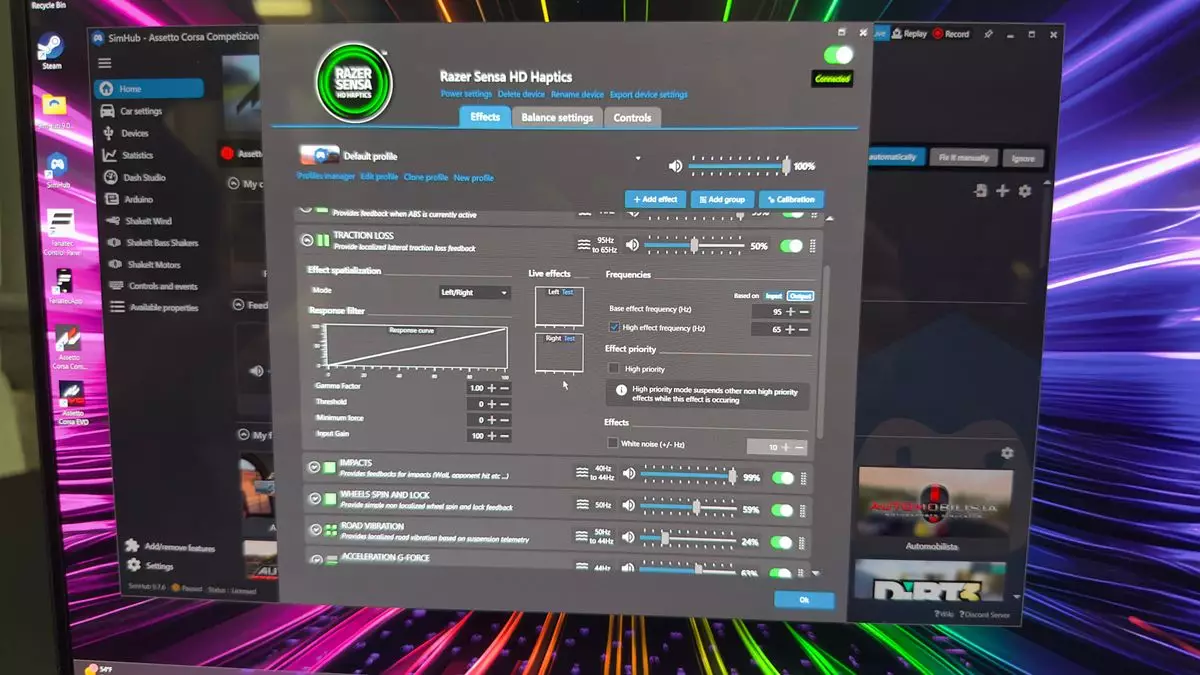In the ever-evolving landscape of gaming technology, Razer has solidly positioned itself as a trailblazer, especially with its recent innovations in haptic feedback devices. Last year, the company unveiled two groundbreaking products: the Freyja seat pad and the Kraken V4 Pro headset. While both have showcased Razer’s commitment to enhancing the gaming experience, they come with caveats that potential buyers should weigh carefully. The Kraken V4 Pro has garnered attention with its superior performance, but the substantial price tag raises eyebrows. On the other hand, the Freyja’s utility is less clear-cut; it prompts gamers to ask themselves: will adding tactile feedback truly transform gameplay?
Haptic Synergy in Sim Racing
At the recent GDC 2025, I had a chance to dive into the synergy these products create when used together during an immersive session of Assetto Corsa Competizione. Picture this: seated on the Freyja pad, the Kraken V4 Pro headset snugly fitted, and harnessing the precision of a Razer/Fanatec direct-drive steering setup. Initial laps in a Lamborghini were dizzying; as I adjusted to the vibrations pulsing through my body from the Freyja, I found the experience unique yet disorienting. At first, the haptics felt like an excess, a gimmicky add-on that echoed rather than resonated with my senses.
However, after a brief acclimation period, a revelation occurred: the haptic feedback began to integrate seamlessly with my driving instincts. The vibrations transformed from background noise into vital nudges that refined my racing technique. I could accurately pinpoint braking points and the nuances of understeering, leading to lap times that dropped remarkably. The senses I had long relied upon—roars of the engine and the tactile feedback from the wheel—were augmented by a new layer of physical interaction. This dual-channel feedback approach arguably enhances the immersion, granting me a deeper understanding of the car’s dynamics without solely relying on auditory cues.
Potential and Pitfalls in Haptic Innovation
Yet, the question lingers: how many gamers will truly appreciate this technology, especially given its steep cost? Sim racing, while a passionate niche within the gaming world, doesn’t boast the massive audience of genres like first-person shooters or RPGs. This market reality poses a significant barrier to widespread adoption. Razer’s ambition of potentially integrating the Freyja pad into a full racing seat is tantalizing, suggesting a future where cornering forces can be felt with greater fidelity. However, history shows that the gaming industry can be fickle when it comes to niche products that require hefty investment.
Razer’s strategies tread a fine line between innovation and market viability. A dedicated sim racing seat that incorporates advanced haptic technology could present an exciting opportunity to fill a gap between rudimentary setups and extravagant motion rigs. With such products often priced in the thousands, the introduction of a mid-range haptic chair could appeal to serious racing enthusiasts while remaining financially feasible. Nevertheless, it’s crucial to remember that gear like this brings risk; if Razer’s new products don’t resonate with consumers, they could find themselves with substantial inventory nightmares.
A Unified Software Experience: The Wyvrn SDK
In addition to hardware innovations, Razer’s unveiling of the Wyvrn software development kit at GDC signals a new era for compatibility and accessibility across gaming platforms. By merging its various SDKs into one robust integration, game developers are empowered to capitalize on Razer’s haptic technologies within Unreal Engine 5.5. This streamlined approach enhances the likelihood that future racing games will leverage the full scope of Razer’s offerings, potentially fueling interest in haptic devices for upcoming titles. This move is notable as it not only supports a diversity of game styles but also enhances the potential user base for these immersive technologies.
Reflecting on the Experience
The true punchline of this exploration lies not just in the emerging technologies but also in their accessibility. The entire experience underscored a personal lament: I don’t own this setup at my home. Sitting there, enveloped in a cocoon of high-tech sensations, it became evident how transformative these advancements could be. However, the practicalities of everyday life—like how my pets might react to a vibrating office—snapped me back to reality. The prospects of haptic feedback raise questions not only about gaming preferences but also about the spaces that house our play environments.
As gamers eagerly await the next wave of innovation, Razer’s focus on integrating tactile feedback into our experiences hints at a thrilling future. Through haptic technology, we might be on the verge of transcending traditional limitations and redefining how we engage with virtual worlds. It remains to be seen whether these efforts will yield a new standard in gaming or if they will fade into the background, yet one thing is certain: the conversation around haptics is just beginning.

